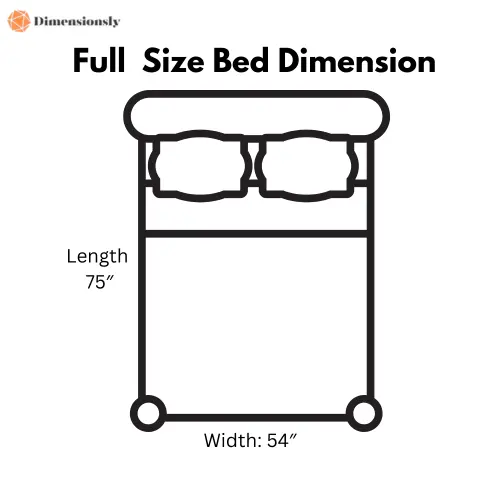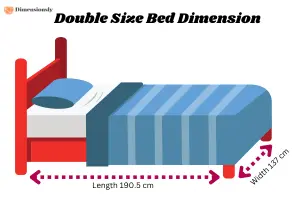A Full (Double) size bed measures 54 inches in width and 75 inches in length (137 cm x 191 cm). It offers more space than a Twin but is more compact than a Queen, making it a practical choice for solo sleepers or couples who prefer a snug sleeping arrangement.

Full (Double) Size Bed Dimensions
| Bed Size | Width (inches) | Length (inches) | Width (cm) | Length (cm) |
|---|---|---|---|---|
| Full (Double) | 54 inches | 75 inches | 137 cm | 191 cm |
What Are the Standard Full-Size Bed Dimensions?
A full-size bed, also called a double bed, measures 54 inches wide by 75 inches long. It offers more space than a twin but is more compact than a queen, making it a versatile choice.
For solo sleepers, this size provides ample room, while couples may find it cramped, as each person gets just 27 inches of space. In smaller rooms, a full bed fits well but may limit additional furniture, while larger spaces might accommodate a queen or king for better comfort.
Choosing a full-size bed means balancing comfort, space, and practicality. If you need extra room to move, consider whether upgrading to a larger size would be a better long-term fit.

Who Is a Full-Size Bed Best For?
A full-size bed is a versatile choice that suits growing children, single adults, and couples in smaller spaces. It provides more room than a twin, making it ideal for those who need extra space to stretch out. However, it’s still compact enough to fit in apartments, guest rooms, and dorms without overwhelming the space.
Balancing Space and Comfort
For single sleepers, a full-size bed offers plenty of room to move without feeling restricted. It’s a great long-term option for teenagers who have outgrown their twin beds and want a more spacious sleeping area. However, for couples, space becomes a challenge. With only 27 inches per person, sleeping comfortably requires some compromise—especially for those who toss and turn at night.
Challenges in Smaller Spaces
While a full-size bed fits well in compact rooms, adding nightstands, dressers, or desks can be tricky. Maximizing space with smart furniture choices, such as under-bed storage or wall-mounted shelves, can help. If you have the room, upgrading to a queen-size bed may be a better option for long-term comfort.

Full-Size Bed vs. Other Mattress Sizes
Before choosing a full-size bed, it’s important to compare it to twin, queen, and king beds to ensure it meets your needs. Each size offers unique advantages, but also comes with trade-offs in space, comfort, and cost.
Twin vs. Full: More Space or More Room Flexibility?
A twin bed (38” x 75”) is great for children, small bedrooms, or multi-bed setups like bunk beds. However, it can feel too narrow for teenagers or adults who need more space. A full-size bed (54” x 75”) provides an extra 16 inches in width, making it a better choice for single sleepers who want more room. The downside? It takes up more floor space, which might be a challenge in smaller rooms.
Full vs. Queen: Comfort vs. Space Efficiency
A queen bed (60” x 80”) is 6 inches wider and 5 inches longer than a full, making it a better option for couples or taller individuals. While a queen offers more personal space per person, it requires a larger bedroom—typically at least 10 x 10 feet—to accommodate additional furniture. If you have limited space, a full-size bed is a more practical choice.
Full vs. King: Budget vs. Luxury
A king bed (76” x 80”) provides plenty of space for couples, but it takes up a significant portion of the room. It also costs more—not just for the mattress but also for bedding and a larger bed frame. If budget and space are concerns, a full-size bed is a more affordable and space-saving alternative.

Room Size Considerations for a Full-Size Bed
A full-size bed requires adequate space for comfortable movement, but it’s also essential to consider how other furniture fits into the room. While it offers a good balance of comfort and space efficiency, placing it in a small room can be challenging without careful planning.
Balancing Bed Size and Room Layout
A full-size bed (54” x 75”) fits well in most bedrooms, but to avoid a cramped layout, the room should be at least 9 x 10 feet. This allows for walking space, nightstands, and essential furniture. In smaller rooms, placing a full-size bed may limit the space available for dressers, desks, or seating areas, making organization more difficult.
Maximizing Space in Small Bedrooms
If you have a compact room, consider space-saving solutions like:
Under-bed storage to reduce clutter
Wall-mounted shelves instead of bulky nightstands
Multi-functional furniture like a bed frame with built-in drawers
While these strategies help, they may not fully compensate for the limited floor space, which could make a twin or lofted bed a more practical alternative.
Choosing the Right Bedding for a Full-Size Bed
Selecting the right bedding for a full-size bed is essential for both comfort and aesthetics. From fitted sheets to duvets, each piece plays a role in creating a cozy and inviting sleep space. However, finding the perfect balance between quality, affordability, and practicality can be challenging.
Balancing Comfort and Budget
A full-size mattress requires fitted sheets measuring 54” x 75”, along with a flat sheet, pillows, and a duvet or comforter. While high-thread-count cotton sheets offer softness and breathability, they can be expensive. On the other hand, microfiber or polyester options are more affordable but may trap heat. Choosing moisture-wicking, durable fabrics ensures year-round comfort without overspending.
Finding the Right Fit
It’s important to select bedding specifically designed for a full-size bed, as queen-sized sheets may be too loose, causing wrinkles and discomfort, while twin sheets won’t fit at all. Additionally, consider deep-pocket fitted sheets if your mattress includes a pillow-top or memory foam topper, as standard sheets may slip off.
Duvets and Comforters: Warmth vs. Breathability
A full-size duvet or comforter typically measures 80” x 90”, offering ample coverage. However, the material and thickness matter. Down-filled comforters provide exceptional warmth but can be pricey and require careful maintenance. Down-alternative options, on the other hand, offer similar coziness at a lower cost and are easier to clean. If you tend to sleep hot, opting for a lightweight, breathable blanket may be a better choice.
Pros and Cons of a Full-Size Bed
A full-size bed offers a great balance between comfort and space efficiency, but it’s important to weigh its benefits and drawbacks before deciding.
Pros
✅ Space-Saving – Fits well in smaller rooms while providing more room than a twin.
✅ Affordable – Cheaper than queen or king beds, including bedding and accessories.
✅ Comfort for Single Sleepers – Offers ample space for one person to stretch out.
✅ Versatile – Works well in guest rooms, apartments, and for growing children.
Cons
❌ Cramped for Couples – At just 27 inches per person, it may feel tight for two.
❌ Not Ideal for Taller Sleepers – The 75-inch length might be too short for people over 6 feet.
❌ Takes Up More Space Than a Twin – May limit furniture placement in small rooms.
Final Thought
A full-size bed is perfect for solo sleepers or smaller spaces, but for couples or taller individuals, a queen or king might be a better option. Consider your space, budget, and comfort needs before choosing.
Tips for Maximizing Space with a Full-Size Bed
Whether you’re working with a small bedroom or just want to make the most of your available space, there are clever ways to arrange and accessorize your full-size bed to maximize both functionality and style.
Use Under-Bed Storage
One of the easiest ways to save space is by utilizing the area under your bed. Consider adding storage bins, drawers, or even a lofted bed frame to create more room for clothes, books, or other items. This simple solution can help clear up valuable floor space and keep your room organized. However, remember that storing too much can make it harder to clean or access your things.
Opt for Multi-Functional Furniture
To make the most of your room, invest in multi-purpose furniture. A full-size bed with a built-in headboard with shelves or a bed frame with storage drawers can eliminate the need for additional furniture pieces, like bulky nightstands. While this setup saves space, it may require a slightly higher upfront cost or a bit of compromise on design.
Maximize Vertical Space
If your room is tight on floor space, consider using wall-mounted shelves for books, lamps, or décor. This allows you to free up nightstands or dressers, making your full-size bed feel more spacious. However, be cautious not to overcrowd the walls, as too much décor can make the room feel cluttered.
Keep Bedding Simple
To maintain an airy and open feel, choose light, neutral bedding and avoid overly bulky comforters or decorative pillows. Minimalist bedding creates a clean, uncluttered look that can make the room feel larger. Just keep in mind that this may not offer the cozy vibe you prefer, so balance simplicity with comfort.
Use Mirrors and Light Colors
Mirrors can reflect light and create the illusion of a larger space. Similarly, light-colored walls and furniture help make the room feel more open and less cramped. While this approach works well, too many mirrors or light colors can make the room feel overly bright or sterile, so find a balance with darker accents.
Conclusion
In conclusion, a full-size bed offers a great balance of comfort, affordability, and space efficiency. However, the tradeoff between personal space and comfort may be challenging for couples. It’s essential to consider your room size, budget, and sleeping preferences to ensure the full-size bed fits your needs effectively.
FAQs
1. How much bigger is a full-size bed compared to a twin bed?
A full-size bed is 54 inches wide by 75 inches long, while a twin bed measures 38 inches wide by 75 inches long. This means a full bed provides 16 inches more width, making it a better option for solo sleepers who need more space.
2. Is a full-size bed suitable for couples?
While a full-size bed can work for couples, it might feel cramped, as each person only gets 27 inches of space. If you or your partner prefer more space to move around at night, consider upgrading to a queen-size bed for extra room.
3. Will a full-size bed fit in a small room?
Yes, a full-size bed is a great option for smaller rooms. Its compact size fits well in spaces like guest rooms or apartments, but make sure to leave enough room for walking and additional furniture like dressers or nightstands.
4. Can a full-size bed accommodate taller individuals?
The standard full-size bed is 75 inches long, which may not be long enough for taller individuals, especially those over 6 feet. In such cases, a full XL bed, which is 80 inches long, could be a better fit.
5. What kind of bedding fits a full-size bed?
For a full-size bed, you’ll need full-size sheets, which are typically 54 inches wide by 75 inches long. Ensure your comforter or duvet is also sized for a full bed to avoid it being too small or too large.
See Also Related Content: